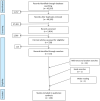Hospice care access inequalities: a systematic review and narrative synthesis
- PMID: 33608254
- PMCID: PMC9125370
- DOI: 10.1136/bmjspcare-2020-002719
Hospice care access inequalities: a systematic review and narrative synthesis
Abstract
Background: Inequalities in access to hospice care is a source of considerable concern; white, middle-class, middle-aged patients with cancer have traditionally been over-represented in hospice populations.
Objective: To identify from the literature the demographic characteristics of those who access hospice care more often, focusing on: diagnosis, age, gender, marital status, ethnicity, geography and socioeconomic status.
Design: Systematic literature review and narrative synthesis.
Method: Searches of Medline, PsycINFO, CINAHL, Web of Science, Assia and Embase databases from January 1987 to end September 2019 were conducted. Inclusion criteria were peer-reviewed studies of adult patients in the UK, Australia, New Zealand and Canada, receiving inpatient, day, outpatient and community hospice care. Of the 45 937 titles retrieved, 130 met the inclusion criteria. Narrative synthesis of extracted data was conducted.
Results: An extensive literature search demonstrates persistent inequalities in hospice care provision: patients without cancer, the oldest old, ethnic minorities and those living in rural or deprived areas are under-represented in hospice populations. The effect of gender and marital status is inconsistent. There is a limited literature concerning hospice service access for the LGBTQ+ community, homeless people and those living with HIV/AIDS, diabetes and cystic fibrosis.
Conclusion: Barriers of prognostic uncertainty, institutional cultures, particular needs of certain groups and lack of public awareness of hospice services remain substantial challenges to the hospice movement in ensuring equitable access for all.
Keywords: chronic conditions; cultural issues; hospice care; service evaluation.
© Author(s) (or their employer(s)) 2022. Re-use permitted under CC BY-NC. No commercial re-use. See rights and permissions. Published by BMJ.
Conflict of interest statement
Competing interests: None declared.
Figures
References
-
- Office for National Statistics . Deaths registered in Engand and Wales 2019 2020.
-
- Office for National Statistics . Deaths registered in England and Wales 2020.
-
- Department of Health . End of life care strategy: promoting high quality care for all adults at the end of life 2008.
-
- National Palliative and End of Life Care Partnership . Ambitions for palliative and end of life care: a national framework for local action 2015-2020 2015.
-
- Dixon J KD, Mastosevic T, Clark M, et al. . Equity in the provision of palliative care in the UK: review of evidence 2015.
Publication types
MeSH terms
LinkOut - more resources
Full Text Sources
Other Literature Sources
Medical
Miscellaneous

